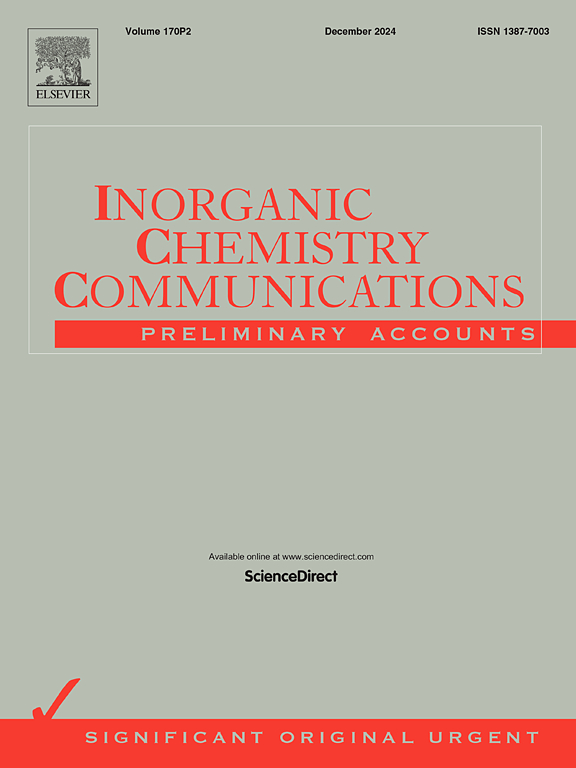Selective and sensitive fluorescence detection of Cr(III) or chromate by a simple derivative of a well-known dibenzodiaza-crown
IF 4.4
3区 化学
Q1 CHEMISTRY, INORGANIC & NUCLEAR
引用次数: 0
Abstract
A sensitive and selective fluorescence (FL) dual chemosensor (L) for the detection of CrO42− or Cr(III) in the presence of background anions, and cations in ethanol: water (8:2, v/v) was synthesized, based on the appending a dibenzodiaza-crown ether macrocycle with two benzimidazole side arms and characterized by FT-IR, 1H NMR, and 13C NMR, UV–visible, FL spectroscopy, X-ray, and elemental microanalyses. The FL emission band for L exhibited enhancement and quenching in the presence of Cr(III) and Cr(VI) (chromate anion) in ethanol: water (8:2, v/v) mixture, respectively, representing a unique property for the determination of these chromium species. In a series of anion competitive experiments, the FL chemosensing behavior of L toward different sodium salts of various anions was also examined, wherein L demonstrates a prompt and selective quenching for chromate anion. LOD values for the chromate anion and Cr(III) were calculated as 180 nM and 1.04 µM, respectively which denoted better LOD of L compared to some other chemosensors with complicated structures such as organometallic frameworks, coordination polymers, and metal clusters. By exploiting 1H NMR titration, molecular electrostatic potential (MEP) map together with information obtained from UV–visible, and FL spectroscopy indicated the interaction of dichromate anion with the N–H of the benzimidazole moiety, however, the interaction of L with Cr(III) was shown through the N-donor groups of both the benzimidazole side arms and the macrocycle ring.

用二苯并二氮杂氮冠的简单衍生物选择性和灵敏地荧光检测铬(III)或铬酸盐
在乙醇:水(8:2,v/v)背景阴离子和阳离子存在的情况下,合成了一种灵敏的选择性荧光(FL)双化学传感器(L),该传感器基于附加的具有两个苯并咪唑侧臂的二苯并二氮杂氮冠醚大环,并通过FT-IR、1H NMR和13C NMR、紫外可见光谱、FL光谱、x射线和元素微量分析对其进行了表征。在乙醇:水(8:2,v/v)混合物中,Cr(III)和Cr(VI)(铬酸盐阴离子)存在时,L的荧光发射带分别表现为增强和猝灭,这是测定这两种铬的独特性质。在一系列阴离子竞争实验中,还研究了L对不同阴离子钠盐的FL化学感应行为,其中L对铬酸盐阴离子表现出快速和选择性猝灭。计算出铬酸盐阴离子和Cr(III)的LOD值分别为180 nM和1.04µM,与其他一些结构复杂的化学传感器(如有机金属框架、配位聚合物和金属簇)相比,L的LOD值更高。通过1H NMR滴定、分子静电势(MEP)图、紫外可见光谱和荧光光谱分析,表明重铬酸盐阴离子与苯并咪唑部分的N-H相互作用,而L与Cr(III)的相互作用则通过苯并咪唑侧臂和大环的n给基来显示。
本文章由计算机程序翻译,如有差异,请以英文原文为准。
求助全文
约1分钟内获得全文
求助全文
来源期刊

Inorganic Chemistry Communications
化学-无机化学与核化学
CiteScore
5.50
自引率
7.90%
发文量
1013
审稿时长
53 days
期刊介绍:
Launched in January 1998, Inorganic Chemistry Communications is an international journal dedicated to the rapid publication of short communications in the major areas of inorganic, organometallic and supramolecular chemistry. Topics include synthetic and reaction chemistry, kinetics and mechanisms of reactions, bioinorganic chemistry, photochemistry and the use of metal and organometallic compounds in stoichiometric and catalytic synthesis or organic compounds.
 求助内容:
求助内容: 应助结果提醒方式:
应助结果提醒方式:


